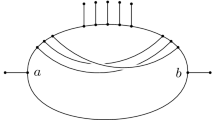Abstract
Processes such as hybridization, horizontal gene transfer, and recombination result in reticulation which can be modeled by phylogenetic networks. Earlier likelihood-based methods for inferring phylogenetic networks from sequence data have been encumbered by the computational challenges related to likelihood evaluations. Consequently, they have required that the possible network hypotheses be given explicitly or implicitly in terms of a backbone tree to which reticulation edges are added. To achieve speed required for unrestricted network search instead of only adding reticulation edges to an initial tree structure, we employ several fast approximate inference techniques. Preliminary numerical and real data experiments demonstrate that the proposed method, PhyloDAG, is able to learn accurate phylogenetic networks based on limited amounts of data using moderate amounts of computational resources.
Access this chapter
Tax calculation will be finalised at checkout
Purchases are for personal use only
Similar content being viewed by others
Notes
- 1.
The implementation is available for download at http://phylomemetic.wordpress.com/2015/04/17/phylodag/.
- 2.
- 3.
References
Aguilar, J.F., Rosselló, J., Feliner, G.N.: Nuclear ribosomal DNA (nrDNA) concerted evolution in natural and artificial hybrids of Armeria (Plumbaginaceae). Mol. Ecol. 8(8), 1341–1346 (1999)
Celeux, G., Diebolt, J.: The SEM algorithm: a probabilistic teacher algorithm derived from the EM algorithm for the mixture problem. Comput. Stat. Q. 2(1), 73–82 (1985)
Dempster, A.P., Laird, N.M., Rubin, D.B.: Maximum likelihood from incomplete data via the EM algorithm. J. Roy. Stat. Soc. Ser. B 39(1), 1–38 (1977)
Durbin, R., Eddy, S.R., Krogh, A., Mitchison, G.: Biological Sequence Analysis: Probabilistic Models of Proteins and Nucleic Acids. Cambridge University Press, Cambridge (1998)
Felsenstein, J.: Evolutionary trees from DNA sequences: a maximum likelihood approach. J. Mol. Evol. 17, 368–376 (1981)
Friedman, N., Ninio, M., Pe’er, I., Pupko, T.: A structural EM algorithm for phylogenetic inference. J. Comput. Biol. 9(2), 331–353 (2002)
Glover, F., Laguna, M.: Tabu Search. Kluwer Academic Publishers, Norwell, MA (1997)
Haeseler, A., Churchill, G.A.: Network models for sequence evolution. J. Mol. Evol. 37(1), 77–85 (1993)
Husmeier, D., Wright, F.: Detection of recombination in DNA multiple alignments with hidden Markov models. J. Comput. Biol. 8(4), 401–427 (2001)
Jin, G., Nakhleh, G., Snir, S., Tuller, T.: Maximum likelihood of phylogenetic networks. Bioinformatics 22, 2604–2611 (2006)
Jukes, T.H., Cantor, C.R.: Evolution of protein molecules. Mamm. Protein Metab. 3, 21–132 (1969)
Meng, C., Kubatko, L.S.: Detecting hybrid speciation in the presence of incomplete lineage sorting using gene tree incongruence: a model. Theor. Popul. Biol. 75(1), 35–45 (2009)
Morrison, D.: Introduction to Phylogenetic Networks. RJR Productions, Uppsala (2011)
Nielsen, S.F.: The stochastic EM algorithm: estimation and asymptotic results. Bernoulli 6, 457–489 (2000)
Park, H.J., Nakhleh, L.: Inference of reticulate evolutionary histories by maximum likelihood: the performance of information criteria. BMC Bioinf. 13(Suppl 19), S12 (2012)
Pearl, J.: Probabilistic Reasoning in Intelligent Systems: Networks of Plausible Inference. Morgan Kaufmann Publishers Inc., San Francisco, CA, USA (1988)
Ronquist, F., Huelsenbeck, J.P.: MrBayes 3: Bayesian phylogenetic inference under mixed models. Bioinformatics 19(12), 1572–1574 (2003)
Saitou, N., Nei, M.: The neighbor-joining method: a new method for reconstructing phylogenetic trees. Mol. Biol. Evol. 4, 406–425 (1987)
Schwarz, G.: Estimating the dimension of a model. Ann. Stat. 6(2), 461–464 (1978)
Sneath, P.H.A.: Cladistic representation of reticulate evolution. Syst. Zool. 24, 360–368 (1975)
Strimmer, K., Moulton, V.: Likelihood analysis of phylogenetic networks using directed graphical models. Mol. Biol. Evol. 17(6), 875–881 (2000)
Strimmer, K., Wiuf, C., Moulton, V.: Recombination analysis using directed graphical models. Mol. Biol. Evol. 18(1), 97–99 (2001)
Tehrani, J., Nguyen, Q., Roos, T.: Oral fairy tale or literary fake? Investigating the origins of Little Red Riding Hood using phylogenetic network analysis. Digital Scholarship in the Humanities (2015, to appear)
Ueda, N., Nakano, R.: Deterministic annealing EM algorithm. Neural Netw. 11(2), 271–282 (1998)
Webb, A., Hancock, J.M., Holmes, C.C.: Phylogenetic inference under recombination using Bayesian stochastic topology selection. Bioinformatics 25(2), 197–203 (2009)
Whelan, S., Lio, P., Goldman, N.: Molecular phylogenetics: state-of-the-art methods for looking into the past. Trends Genet. 17(5), 262–272 (2001)
Yu, Y., Dong, J., Liu, K.J., Nakhleh, L.: Maximum likelihood inference of reticulate evolutionary histories. Proc. Nat. Acad. Sci. 111(46), 16448–16453 (2014)
Acknowledgments
This work was supported in part by the Academy of Finland (Center-of-Excellence COIN). We are grateful to Vincent Moulton for insightful comments. The anonymous reviewers suggested a comparison to the PhyloNet method and made several other suggestions that significantly improved the paper.
Author information
Authors and Affiliations
Corresponding author
Editor information
Editors and Affiliations
Rights and permissions
Copyright information
© 2015 Springer International Publishing Switzerland
About this paper
Cite this paper
Nguyen, Q., Roos, T. (2015). Likelihood-Based Inference of Phylogenetic Networks from Sequence Data by PhyloDAG. In: Dediu, AH., Hernández-Quiroz, F., Martín-Vide, C., Rosenblueth, D. (eds) Algorithms for Computational Biology. AlCoB 2015. Lecture Notes in Computer Science(), vol 9199. Springer, Cham. https://doi.org/10.1007/978-3-319-21233-3_10
Download citation
DOI: https://doi.org/10.1007/978-3-319-21233-3_10
Published:
Publisher Name: Springer, Cham
Print ISBN: 978-3-319-21232-6
Online ISBN: 978-3-319-21233-3
eBook Packages: Computer ScienceComputer Science (R0)




